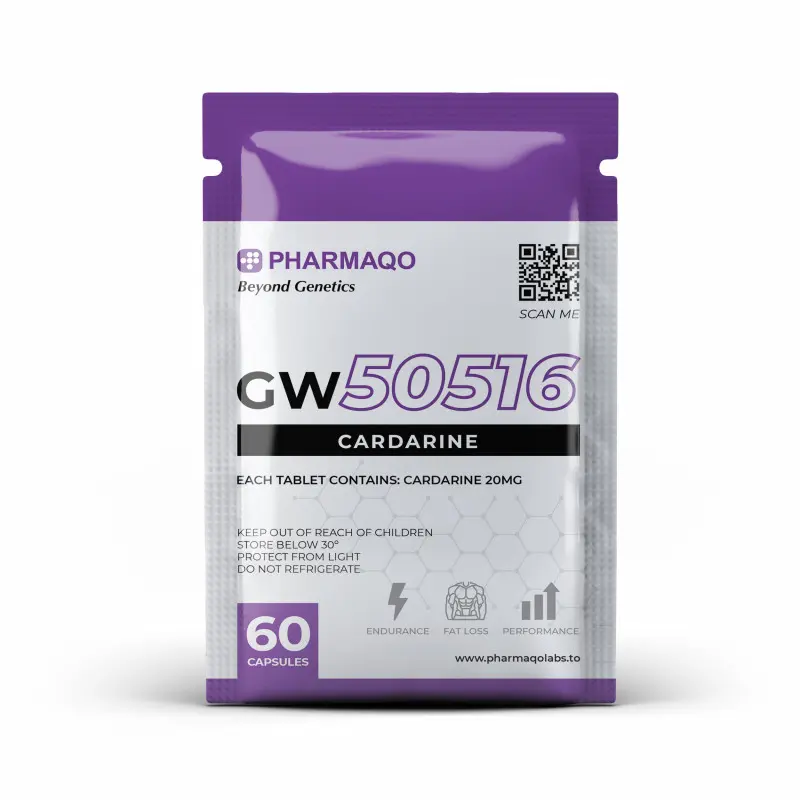Disclaimer: This article is for educational purposes only. It is not intended to diagnose, treat, or advise on medical issues. Always consult with a healthcare professional before starting any new supplement or fitness program.
Overview of Cardarine
Cardarine, also known as GW-501516, is a research chemical with unique effects on metabolism and physical performance. This compound has gained attention for its potential benefits and controversial status.

Chemical Profile of GW-501516
GW-501516 is a synthetic drug with the chemical formula C21H18F3NO3S. It has a molecular weight of 453.4 g/mol. The compound is usually found as a white to off-white solid. GW-501516 is not water-soluble but dissolves in organic solvents.
Key features of its structure:
- Thiazole ring
- Trifluoromethyl group
- Carboxylic acid moiety
These elements contribute to its ability to bind to specific receptors in the body.
PPAR Receptor Agonist Mechanism
Cardarine works as a PPAR receptor agonist. It targets the peroxisome proliferator-activated receptor delta (PPARδ). When activated, PPARδ affects gene expression related to energy metabolism.(1)
Effects of PPARδ activation include:
- Increased fatty acid oxidation
- Enhanced glucose uptake in muscles
- Improved insulin sensitivity
These changes can lead to better endurance and fat burning. The body shifts towards using fat for energy instead of carbohydrates.
History and Development
GlaxoSmithKline and Ligand Pharmaceuticals developed GW-501516 in the 1990s. The initial goal was to treat metabolic and cardiovascular diseases. Early studies showed promise for conditions like obesity and diabetes.
Research timeline:
- 1990s: Initial development
- Early 2000s: Clinical trials begin
- 2007: Development halted due to safety concerns
Despite being dropped by pharmaceutical companies, interest in Cardarine continued in other circles. Athletes and bodybuilders began using it as a performance enhancer.
Legal Status and Banned Substance Classifications

Cardarine is not approved for human use in any country. Its legal status varies globally. In most places, it’s considered a research chemical.(2)
Key points on legal status:
- Not approved as a medication
- Illegal to sell for human consumption in many countries
- Often falls into a legal grey area
The World Anti-Doping Agency banned GW-501516 in 2009. It’s classified as a metabolic modulator. Athletes caught using it face disqualification and other penalties. (3)
Reasons for the ban:
- Potential to enhance performance unfairly
- Safety concerns, including cancer risk in animal studies
- Lack of approval for human use
Health and Performance Benefits
Cardarine offers several potential benefits for metabolism, endurance, and cardiovascular health. Research suggests it may impact fat burning, athletic performance, and lipid profiles.
Impact on Metabolism and Fat-burning

Cardarine appears to boost fat metabolism. It activates PPAR-delta receptors, which play a role in energy use. This activation may increase fatty acid oxidation and energy expenditure.
Studies in animals show Cardarine can reduce body fat. It seems to help burn stored fat for fuel. This could aid weight loss efforts.
Cardarine may also improve insulin sensitivity. Better insulin function can support healthy metabolism. This could help maintain stable blood sugar levels.
Effects on Endurance and Athletic Performance
Cardarine shows promise for boosting endurance. Research indicates it can increase exercise capacity in both humans and animals.
In one study, mice given Cardarine ran almost twice as far as untreated mice. Human trials have found similar endurance gains.
The compound appears to enhance stamina by changing muscle fiber types. It may shift muscle fibers towards more fatigue-resistant types. This could allow for longer periods of sustained activity.
Cardarine might also improve recovery between workouts. Faster recovery could allow for more frequent training sessions.
Influence on Lipid Profile and Cardiovascular Health
Cardarine may positively affect cholesterol levels. Studies show it can raise HDL (good) cholesterol while lowering LDL (bad) cholesterol.
In one trial, Cardarine raised HDL levels by up to 79% in some participants. It also reduced triglycerides by 20-30%.
These changes in lipid profiles could benefit heart health. Improved cholesterol balance may lower the risk of cardiovascular disease.
Cardarine might also reduce inflammation in blood vessels. Less inflammation could protect against atherosclerosis. This effect may further support cardiovascular health.
Cautions and Side Effects

Cardarine (GW-501516) has several potential health risks and side effects that users should be aware of. These include cancer concerns, liver toxicity, and complications during pregnancy.
Potential Risks and Adverse Reactions
Cardarine may cause various adverse reactions in users. Common side effects can include headaches, nausea, and fatigue. Some people report muscle cramps or joint pain when taking this substance.(4)
Less common but more serious reactions may occur. These can involve changes in blood pressure, heart rhythm abnormalities, or allergic responses. Users should monitor their bodies closely for any unusual symptoms.
It’s important to note that long-term effects of Cardarine use in humans are not well-studied. The substance was never approved for human use, so data on its safety profile is limited.
Cardarine and Cancer Risk
One of the most significant concerns with Cardarine is its potential cancer risk. Animal studies showed an increased rate of cancer development in multiple organs when exposed to GW-501516.(5)
These findings were so concerning that further human trials were halted. The cancer risk is believed to be linked to Cardarine’s effects on cell proliferation and metabolism.
While human data is lacking, the animal study results are considered a serious red flag. This cancer risk is a primary reason why many health organizations strongly advise against using Cardarine.
Liver Toxicity Concerns

Liver health is another major concern with Cardarine use. Some studies have suggested that GW-501516 may cause liver damage or increase the risk of liver toxicity.(6)
Signs of liver stress may include:
- Jaundice (yellowing of skin or eyes)
- Abdominal pain
- Dark urine
- Fatigue or weakness
Users of Cardarine should be vigilant for these symptoms. Regular liver function tests are advisable for anyone considering or currently using this substance.
The exact mechanisms of Cardarine’s effects on liver health are not fully understood. More research is needed to determine the full extent of potential liver risks.
Implications During Pregnancy
Cardarine use during pregnancy poses serious risks. The substance can cross the placental barrier, potentially affecting fetal development.
Animal studies have shown that GW-501516 may cause:
- Birth defects
- Developmental issues
- Increased risk of gestational diabetes
Pregnant women or those planning to become pregnant should avoid Cardarine entirely. The potential harm to the developing fetus far outweighs any perceived benefits.
Even after stopping Cardarine use, it’s recommended to wait before trying to conceive. This allows time for the substance to clear from the body, reducing potential risks to early fetal development.
Cardarine in Medical Context
Cardarine (GW-501516) has shown potential in various medical applications. Research has explored its effects on metabolic disorders, weight management, and lipid profiles.
Applications in Diabetes Management
Cardarine may improve insulin sensitivity in people with type II diabetes. Studies suggest it can lower blood glucose levels and reduce insulin resistance.
GW-501516 has been investigated for its ability to regulate glucose metabolism. In animal trials, it increased glucose uptake in muscle tissue.(7)
This could lead to better blood sugar control for diabetic patients. Researchers are examining how Cardarine affects insulin production and utilization in the body.
Role in Obesity and Weight Loss Strategies
Cardarine may help with weight loss by boosting metabolism and fat burning. It appears to increase energy expenditure and reduce fat storage.
Studies show GW-501516 can activate genes involved in fatty acid oxidation. This promotes the use of fat for energy instead of storing it.
Some research indicates Cardarine could reduce appetite and food intake. However, more human trials are needed to confirm these effects for obesity treatment.
Treatment Potential for Lipid Disorders
Cardarine shows promise in managing lipid disorders like hyperlipidemia. It may help lower triglycerides and improve cholesterol profiles.
Research suggests GW-501516 can decrease LDL (bad) cholesterol levels. At the same time, it might increase HDL (good) cholesterol.
These effects could benefit patients with high cholesterol or triglycerides. Cardarine’s impact on lipid metabolism makes it interesting for heart health research.
Some studies also indicate potential benefits for reducing hypertension. However, more clinical data is needed to fully understand its effects on blood pressure.
Usage and Administration

Cardarine has specific dosing protocols and administration methods. It comes in various forms and can be combined with other compounds. Availability may be limited due to its status.
Recommended Dosage and Cycle Length
The typical dosage range for Cardarine is 10-20 mg per day. Most users start at 10 mg and may increase to 20 mg if needed. Cycles usually last 8-12 weeks.
Higher doses have not shown additional benefits and may increase side effect risks. It’s best to start low and assess tolerance.
Cardarine has a half-life of 16-24 hours. Many users split the daily dose into two servings for more stable levels.
Product Formulation and Bioavailability
Cardarine is available in liquid and capsule forms. Liquid solutions are more common and may offer better absorption.
Oral bioavailability is estimated at 20-25%. Taking it with a small fatty meal can improve absorption.
Some users report faster effects from sublingual administration under the tongue. However, this method lacks research.
Stacking with Other Compounds
Cardarine is often stacked with SARMs like Ostarine for enhanced fat loss and endurance. A typical stack might include:
- Cardarine: 10-20 mg daily
- Ostarine: 15-25 mg daily
It may also be combined with MK-677 for muscle growth. Careful dosing is key when stacking multiple compounds.
Sources and Availability
Cardarine is not approved for human use. It’s sold as a “research chemical” through some online vendors. At Steroiduck we offer lab-tested high quality Cardarine GW501516 for sale.
Quality and purity can vary widely in the black market. Third-party lab testing is crucial to verify product authenticity.(8)
Some countries have banned Cardarine, making it illegal to purchase or possess. Users should check local laws before obtaining it.
Scientific Research and Studies

Cardarine (GW-501516) has been the subject of various scientific studies. These have looked at its effects on metabolism, disease, and athletic performance. Research has provided insights into how this compound works in the body.
Clinical Trials on Cardarine
Early clinical trials tested Cardarine’s effects on metabolism and heart health. One study looked at its impact on lipid levels and insulin sensitivity in overweight adults. The results showed improved cholesterol profiles and insulin response.
Another trial focused on Cardarine’s ability to boost fatty acid oxidation. This process helps burn fat for energy. Participants saw increased fat burning and better endurance during exercise.(9)
Some trials also explored Cardarine’s potential to treat metabolic diseases. These studies looked at its effects on blood sugar control and obesity. While early results seemed promising, safety concerns halted further human trials.
Research on Metabolic Diseases
Scientists have studied Cardarine’s impact on metabolic health in lab settings. Animal studies showed it could improve glucose metabolism and reduce inflammation. This sparked interest in its potential for treating diabetes and obesity.(10)
Research also looked at Cardarine’s effects on visceral fat. This is the harmful fat that builds up around organs. Studies in mice found it could decrease visceral fat accumulation and improve liver function.
Some work explored Cardarine’s role in preventing heart disease. It appeared to lower bad cholesterol and raise good cholesterol in animal models. These effects could help protect against heart problems linked to poor metabolism.
Investigations into Athletic Applications
Cardarine caught the attention of researchers studying athletic performance. Its ability to enhance endurance made it interesting for sports science. Studies in animals showed increased running distance and time to exhaustion.
Some work looked at Cardarine’s effects during cutting cycles in bodybuilding. These are periods when athletes try to lose fat while keeping muscle. Lab tests suggested it could help preserve muscle mass during calorie restriction.(11)
Research also explored how Cardarine affects recovery from intense exercise. It seemed to reduce inflammation and muscle damage in animal studies. This could potentially help athletes train harder and recover faster.
Comparative Analysis

Cardarine stands out among performance-enhancing compounds. It differs from other substances in key ways that affect its use and results.
Cardarine vs. Other SARMs
Cardarine (GW-501516) is often grouped with SARMs, but it works differently. SARMs bind to androgen receptors, while Cardarine activates PPAR-delta receptors. This means Cardarine doesn’t affect testosterone levels like SARMs do.(12)
Unlike Ostarine, which can suppress natural hormone production, Cardarine doesn’t have this effect. It focuses on boosting endurance and fat loss without muscle growth.
Cardarine users report fewer side effects compared to SARM users. However, long-term safety data for both is limited.
Performance Comparison to Other PPAR Agonists
Cardarine is a potent PPAR-delta agonist. It stands out for its strong effects on endurance and fat burning.
Other PPAR agonists like fibrates mainly target cholesterol levels. Cardarine has a broader impact on metabolism and athletic performance.
In studies, Cardarine showed superior results in:
- Increasing endurance
- Enhancing fat oxidation
- Improving insulin sensitivity
These effects make it popular among athletes and bodybuilders seeking performance gains.
Contrast with Alternative Fat-loss Supplements
Compared to traditional fat burners, Cardarine works through different mechanisms. Many fat-loss supplements rely on stimulants to boost metabolism.
Cardarine doesn’t act as a stimulant. It changes how the body uses energy, favoring fat as a fuel source. This can lead to steady fat loss without the jitters or crashes associated with caffeine-based products.
Unlike supplements like chromium or vitamin C, which have indirect effects on fat loss, Cardarine directly influences fat metabolism. Its effects are often more noticeable and rapid.
However, Cardarine lacks the long-term safety data of established supplements. This makes it a higher-risk option for fat loss.
Frequently Asked Questions
GW-501516, also known as Cardarine, has generated interest and questions among researchers and athletes. Here are some common queries about this compound.
What are the potential side effects of using GW-501516?
GW-501516 may cause side effects in some users. These can include headaches, nausea, and stomach discomfort. Some studies have raised concerns about potential long-term health risks.
Users should be aware of possible cardiovascular effects. Regular health check-ups are advised for those considering this compound.What results can be expected before and after using this compound?
Users often report increased endurance and fat loss when taking GW-501516. Some notice improved athletic performance and faster recovery times.
Physical changes may include a leaner appearance and increased muscle definition. Results can vary based on diet, exercise, and individual factors.How quickly can effects be seen from GW-501516?
Many users report feeling effects within the first week of use. Increased energy levels and endurance are often the first noticeable changes.
Visible body composition changes typically take several weeks to become apparent. Consistent use and a proper diet and exercise regimen can influence the timeline.What benefits are associated with taking GW-501516?
GW-501516 has been linked to improved endurance and fat burning. Users often report increased energy levels and better exercise performance.
The compound may help with fat loss while preserving muscle mass. Some studies suggest potential benefits for metabolic health.Why was the development of GW-501516 eventually halted?
Development of GW-501516 was stopped due to safety concerns. Animal studies showed potential links to cancer development with long-term use.
These findings led to the termination of human trials. The compound is now banned by anti-doping agencies for use in competitive sports.
Dr. Grant Fourie, a specialist in male hormones, is based in Cape Town, South Africa. He provides comprehensive treatments for conditions related to low testosterone, such as erectile dysfunction, fatigue, and mood changes. His methods include hormone replacement therapy and other modern treatment options.
Contact me via email or phone to book personal appointment in my clinic: The Village Square, Cape Town - South Africa



